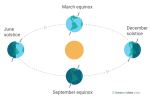![[Spring Tulip]](https://riverhouses.org/wp-content/uploads/2024/03/tulip-spring-emoji.png) Today is the March equinox — we call it the vernal or spring equinox in the northern hemisphere, but in the southern hemisphere it’s the autumnal or fall equinox. The vernal equinox is (in astronomical terms) the first day of spring, just as the autumnal equinox is (in astronomical terms) the first day of fall.
Today is the March equinox — we call it the vernal or spring equinox in the northern hemisphere, but in the southern hemisphere it’s the autumnal or fall equinox. The vernal equinox is (in astronomical terms) the first day of spring, just as the autumnal equinox is (in astronomical terms) the first day of fall.
❡ Little lessons to speak aloud: “Ah, vernal and autumnal are beautiful words. Let’s look them both up in our big dictionary.”
Whenever you’re investigating things temporal or calendrical, the timeanddate.com website is always a good place to start:
The seasons occur because the earth’s axis of daily rotation is not quite perpendicular to the plane of the earth’s annual orbit around the sun (it’s tilted by about 23°). The two solstices occur at the points in the orbit when the north pole of the axis of rotation is tilted either (a) most directly away from the sun (in December, on the first day of northern-hemisphere winter), or (b) most directly toward the sun (in June, on the first day of northern-hemisphere summer). The two equinoxes, in September and March, occur when the earth’s axis of rotation is fully “sideways” to the sun (so to speak), making the intervals of daylight and darkness equal (or very nearly so). The word equi-nox means “equal night” (and day).
![[Earth's Orbit and the Seasons]](https://riverhouses.org/wp-content/uploads/2018/12/equinox-solstice.png)
NASA has a fun educational crossword puzzle for kids that’s filled with seasonal vocabulary — solstices, equinoxes, and more.
![[Seasonal Crossword]](https://www.nasa.gov/wp-content/uploads/2019/03/edu_solstice_puzzle_0.png)
You can print out your own copy at NASA’s “For Educators” website. And you can find many more technical facts and figures about solstices and equinoxes in your recommended homeschool almanac.
What calendrical events and astronomical alignments will you and your students be marking in your homeschool this Leo Term? 🌷
❡ Watchers of the skies: Teaching your students about the seasons and the stars is one of the simplest and most enduring gifts you can give them. Your recommended River Houses astronomy guide has descriptions and maps of all the constellations that point out the seasonal highlights, and the astronomical section of your recommended world atlas has beautiful large charts of both celestial hemispheres. Why not find a dark-sky spot near you this month and spend some quality homeschool time beneath the starry vault. 🔭
❡ Here, said the year: This is one of our regular posts on Homeschool Astronomy and on the Homeschool Year. Add your name to our free weekly mailing list to get great homeschool teaching tips delivered right to your mailbox, fall, winter, spring, and summer. 🍂 ⛄️ 🌷 ⛱
❡ Homeschool calendars: We have a whole collection of free, printable, educational homeschool calendars and planners available on our main River Houses calendar page. They will help you create a light and easy structure for your homeschool year. Give them a try today! 🗓
❡ Support our work: If you enjoy our educational materials, please support us by starting your regular Amazon shopping from our very own homeschool teaching supplies page. When you click through from our page, any purchase you make earns us a small commission at no extra cost to you. Thank you for helping us to keep going and growing! 🛒
❡ Join us! The aim of the River Houses project is to create a network of friendly local homeschool support groups — local chapters that we call “Houses.” Our first at-large chapter, Headwaters House, is now forming and is open to homeschoolers everywhere. Find out how to become one of our founding members on the Headwaters House membership page. 🏡


